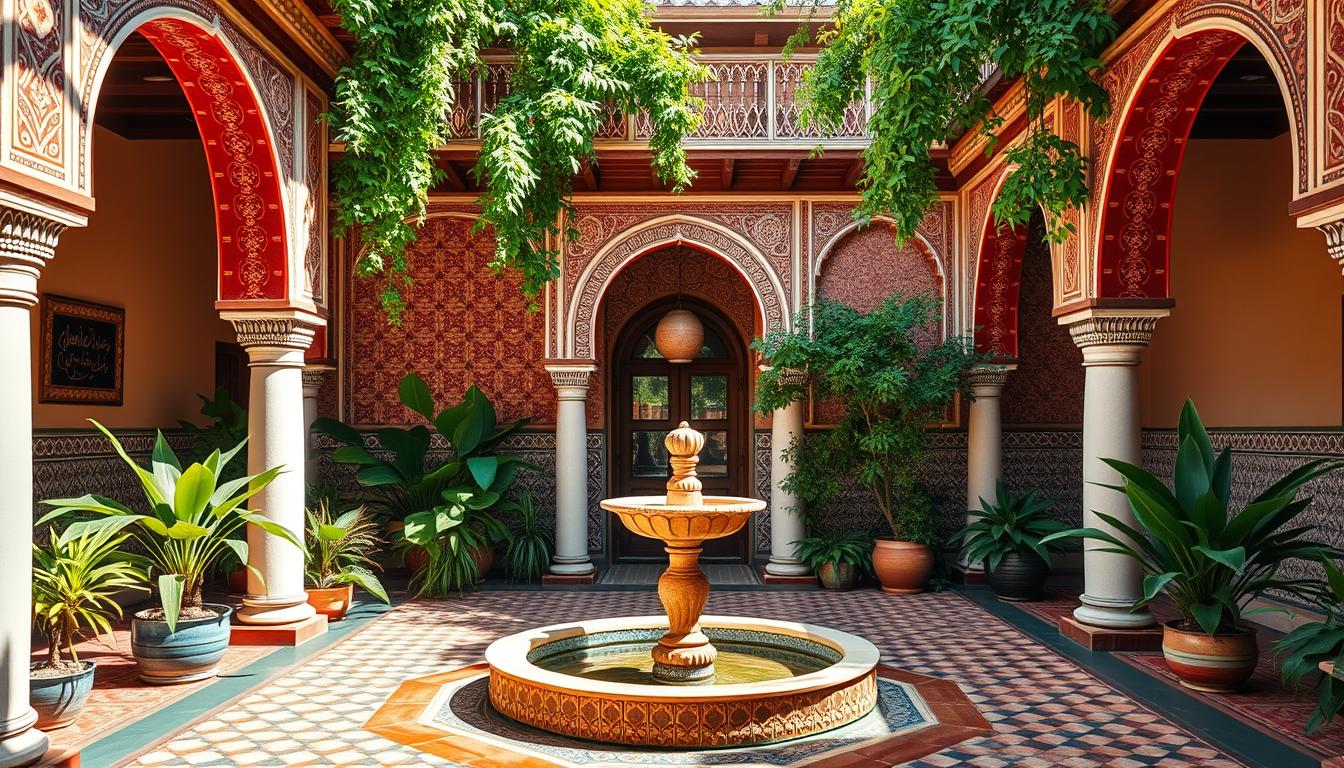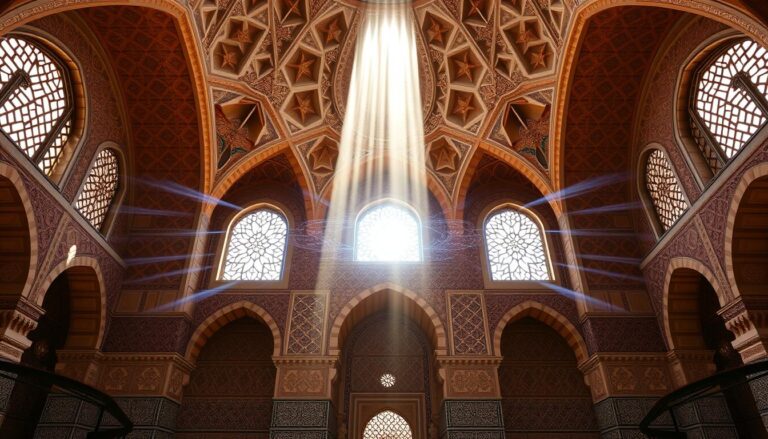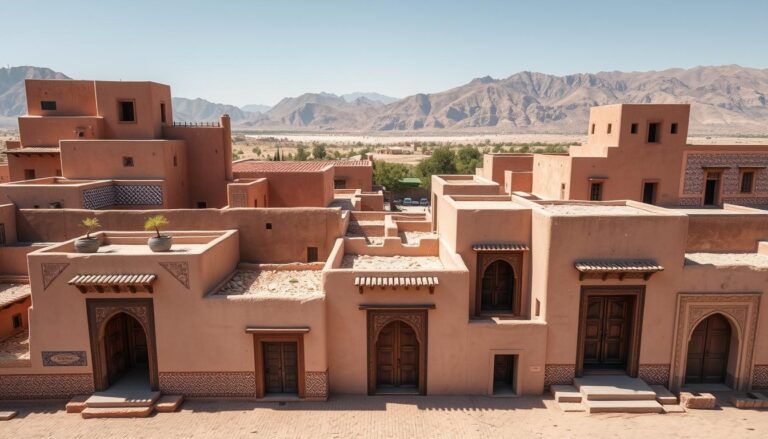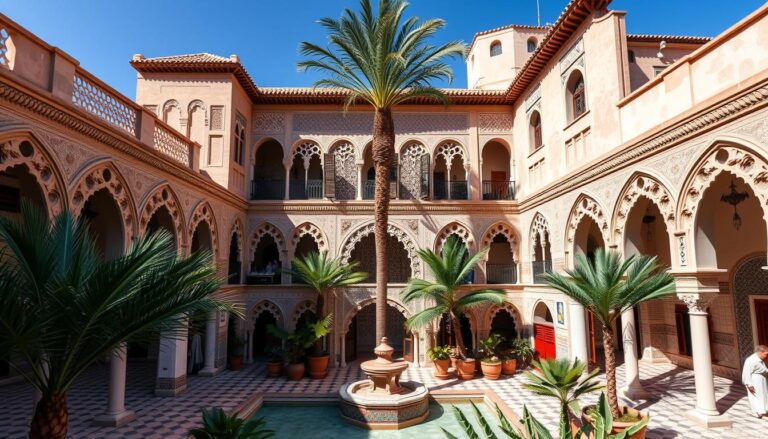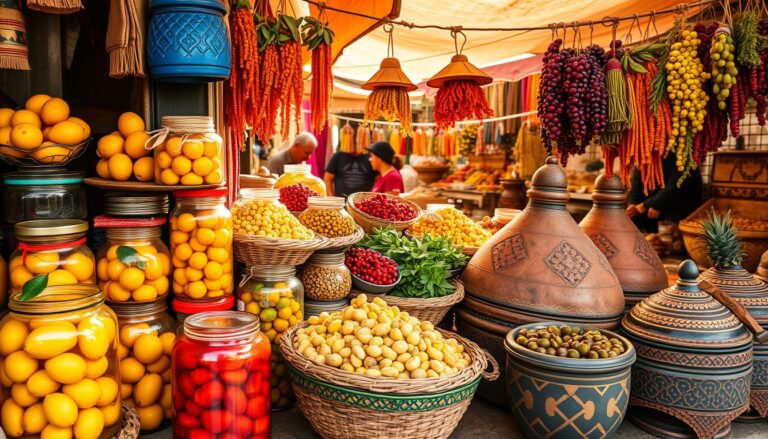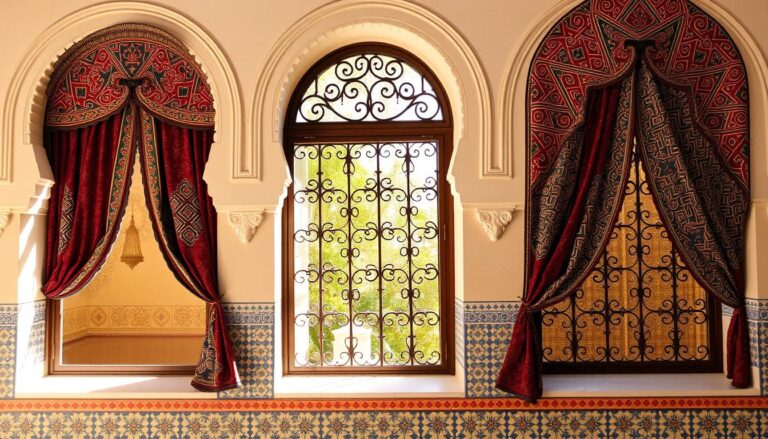Could the stunning architecture and captivating artistry of Morocco have roots in the cultural legacy of Andalusia? Let’s explore the intricate design influences that have shaped Morocco’s iconic look. We’ll see how this Iberian civilization has deeply influenced the kingdom’s artistic heritage.
Key Takeaways
- Moroccan architecture and design are deeply rooted in the Andalusian civilization’s artistic legacy.
- The migration of Moors and Jews from Spain to North Africa brought Andalusian cultural elements to Morocco.
- Moroccan design features iconic elements like Zellige tiles, intricate woodcraft, and brass artistry that have their origins in Andalusia.
- The fusion of Andalusian, Berber, and Islamic influences has created the distinctive Moroccan aesthetic.
- Exploring the Andalusian roots of Moroccan design offers insights into the country’s rich cultural heritage.
The Andalusian Roots of Moroccan Architecture
Morocco’s rich architecture started in the 8th century. This was when the Iberian Peninsula was ruled by the Andalusian civilization. The Umayyad Caliphate’s expansion into Al-Andalus, now southern Spain, created a unique blend of cultures.
The Cultural Synthesis of Al-Andalus
This mix of cultures led to a special architectural style. It featured geometric patterns, detailed carvings, and bright colors. Andalusian architects and artisans perfected their craft, creating beautiful and functional buildings.
The Migration of Artisans to Morocco
In the 10th century, many Moorish artisans and intellectuals moved to Morocco. They brought their architectural and artistic traditions with them. This led to a unique Moroccan style that combined Andalusian elegance with local heritage.
“The roots of Moroccan architecture can be traced back to the 8th century, during the height of the Andalusian civilization in Al-Andalus, present-day southern Spain.”
Iconic Elements of Andalusian-Inspired Moroccan Design
Zellige tiles are a key feature of Moroccan architecture, coming from Andalusian tile-making traditions. These tiles have intricate geometric patterns inspired by the divine. They are made by hand, a tradition that has lasted for centuries.
Woodcraft is also a big part of Moroccan architecture, thanks to Andalusian influence. During the medieval period, wood was used to make ornate doors, ceilings, and furniture. Artisans used Andalusian techniques to create detailed patterns and motifs that showed the culture and beliefs of the time.
The History and Craftsmanship of Zellige Tiles
Zellige tiles are known for their stunning geometric patterns, showing the lasting impact of Andalusian influence. These handcrafted tiles are a key part of Moroccan architecture. Moroccan artisans have kept this ancient craft alive, making Zellige tilework continue to amaze and inspire.
The Art of Woodcraft in Moroccan Architecture
Moroccan architecture is famous for its beautiful woodwork, a tradition from the Andalusian period. Moroccan artisans have mastered the art of intricate wood carving. They create stunning doors, ceilings, and furniture that show the region’s rich heritage.
Brass Artistry and Its Historical Significance
Brass has been a favorite in Moroccan decor since the Andalusian period. Andalusian artisans brought brass engraving to Morocco, making everything from lighting fixtures to decorative trays. This tradition of brass artistry is a big part of Moroccan design, showing the region’s architectural heritage.
“The intricate geometric patterns that define Zellige mosaics were inspired by the desire to create art that reflects the infinite nature of the divine.”
The Evolution of Zellige Tilework in Morocco
Zellige tiles have a long history in Morocco, starting in the 8th century. Moorish artisans from Andalusia brought these tile-making skills to North Africa. They were fleeing the Reconquista in Spain and brought Islamic art and architecture with them.
Early Adoption and Integration of Zellige Tiles
Zellige tiles were a big change in Moroccan design. These ceramic mosaics, with their geometric patterns and bright colors, quickly became part of buildings. They decorated walls, floors, and fountains in mosques, palaces, and other important places.
The Flourishing of Zellige Craftsmanship under the Almoravid and Almohad Dynasties
The 12th century was a key time for Zellige tilework in Morocco. The Almoravid and Almohad dynasties supported the arts and architecture a lot. They helped Zellige craftsmanship grow.
The Almoravid rulers made Marrakech a capital and started big architectural projects with Zellige tiles. The Almohads then took over and kept using Zellige in their buildings. This made Zellige a big part of Moroccan architecture.
The support from these dynasties made Zellige tile-making better. Artisans, called Maallems, created special tools and methods. They made the unique geometric designs we see in Moroccan buildings today.
Andalusian influence on Moroccan design
The Andalusian civilization’s impact on Moroccan architecture goes beyond just materials and techniques. It touches the heart of the spaces, bringing peace and spiritual connection. Whether it’s a grand palace or a simple home, the blend of Zellige tiles, wood, and brass creates spaces that are beautiful and full of meaning.
Design principles and craftsmanship from centuries ago still inspire today. They offer endless ways to create spaces that are both luxurious and deeply rooted in culture. This Moorish-Moroccan architectural synthesis has lasted through time, captivating everyone who sees it.
The Andalusian civilization’s influence is not just in the buildings. It’s in the very essence of the spaces. From the Zellige tiles to the woodwork and brass, each detail carries a rich cultural story. This story continues to inspire and amaze.
“The combination of Zellige tiles, woodcraft, and brass artistry creates environments that are both aesthetically pleasing and deeply meaningful.”
With the Moroccan constitution recognizing Andalusian culture, its influence on design will only grow. This long-standing relationship, built on cultural exchange and artistic collaboration, has created a unique architectural language. This language continues to enchant the world.
The Enduring Legacy of Andalusian Design
The Andalusian impact on Moroccan architecture and design goes beyond just buildings. It touches the heart of the spaces, bringing peace and spiritual connection. This has lasted through time.
- The seamless blend of Zellige tiles, wood, and brass creates spaces that are both beautiful and meaningful.
- The design principles and craftsmanship from centuries ago are still relevant today, offering endless possibilities for creating spaces that are luxurious and culturally rich.
- This Moorish-Moroccan architectural synthesis has captivated both locals and visitors alike with its timeless allure.
As Morocco officially recognizes Andalusian culture, its influence on design will continue to inspire and enchant the world for generations to come.
The Timeless Allure of Moorish Architecture
Moroccan architecture is loved by many around the world. It features beautiful mosaics, detailed wood carvings, and shiny brass decor. This style brings together history, art, and tradition in a unique way.
The Timeless beauty of Moorish architecture and the Enduring appeal of Moroccan architectural traditions started in Al-Andalus. This place was where Islamic and local art traditions merged. When Moorish artists moved to Morocco, they brought their skills with them. These skills helped shape the famous Moroccan design.
“Moroccan architecture encompasses a unique fusion of Islamic and Andalusian styles, creating a timeless aesthetic that continues to inspire and captivate audiences globally.”
Zellige tilework, woodcraft, and brass artistry show the lasting charm of Moroccan design. These elements together form a cultural heritage that is still celebrated today.
By admiring Moroccan craftsmanship, we pay tribute to its rich history and cultural legacy. The Timeless beauty of Moorish architecture and the Enduring appeal of Moroccan architectural traditions still amaze and inspire us. They invite us to explore the timeless beauty of this artistic legacy.
Conclusion
The history of Moroccan architecture is a fascinating tale of cultural exchange and artistic skill. It is rooted in the Andalusian civilization, leading to some of the world’s most stunning designs. Moroccan architecture blends Islamic, Roman, and Berber styles, creating a unique beauty that lasts.
Exploring Moroccan design helps us understand the deep cultural ties that have shaped it. The legacy of Moroccan architecture, influenced by Andalusia, inspires people everywhere. This shows how cultural exchange can create lasting beauty.
The Moroccan architectural tradition, born from Andalusian roots, has made a lasting impact globally. It is known for its Zellige tiles and skilled wood and brass work. This heritage continues to inspire and influence design trends worldwide, telling a story of cultural exchange and timeless beauty.
Source Links
- The Judeo-Andalusian Traditions of Morocco — Gerard Edery
- Moroccan architecture
- The Moroccan Influence in Andalucia • Grapevine Lifestyle
- A Journey Through Andalusian Influence and Artistic Mastery – Art Maze
- From Islamic to Art Deco: A rich history of Moroccan architecture
- The Rich and Vibrant History of Moroccan Architecture.
- Moorish architecture
- Andalusian and Maghrebi Art and Architecture | Islamic Art and Architecture Class Notes | Fiveable
- Moorish Architecture in Andalusian Cities: A Deep Dive
- From Andalusia to the Almohad: A History of Moroccan Zellige Tile – Design Dash
- Zellij – The Prince of Tiles History | Zellij Gallery
- Historic Origins of Zellige Tiles | Paris Tile
- Spanish Influence in Morocco – Journey Beyond Travel
- Morocco recognises Andalusian influence | The National
- Exploring the Timeless Beauty of Moroccan Architecture | African Sahara
- Moorish Architecture: The Majestic Designs of Al-Andalus –
- 10 Powerful Ways Al-Andalus Art Merged Western And Islamic Worlds – MemoryCherish
- The Role of Moroccan Culture in Its Export Market

The Editorial Team is a passionate group of Morocco enthusiasts dedicated to sharing the beauty, culture, and wonders of this captivating country. With diverse backgrounds and a deep love for travel, we strive to bring you engaging and informative content that inspires your Moroccan adventures. From uncovering hidden gems and sharing local insights to exploring mouthwatering cuisine and showcasing the vibrant lifestyle, our team is committed to providing you with valuable resources and exciting stories that enhance your exploration of Morocco. Join us on this journey as we celebrate the rich heritage and unforgettable experiences that make Morocco truly special.

